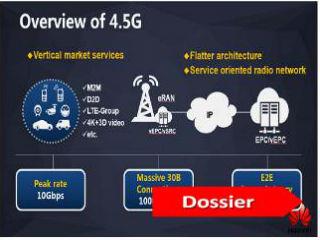It was said that although the 4.5G tech included prospective 5G features like low latency and virtualisation, it is unlikely it would delay the introduction of 5G. Huawei is aiming to plant its flag in the 5G hill within a few years.

The Chinese tech giant Huawei is promising a ‘4.5G’ mobile networking solution by 2016 that will deliver more than 1 Gbit/s in throughput with 10 milliseconds latency.
by
N. Peter Kramer
The Chinese tech giant Huawei is promising a ‘4.5G’
mobile networking solution by 2016 that will deliver more than 1 Gbit/s in
throughput with 10 milliseconds latency.
It would be aimed at bridging the gap between 4G and 5G: 4.5G is the
natural evolution of 4G. It offers enhancements to meet new services, in
particular to meet the growth of the Internet of Things (IoT). It was said that
although the 4.5G tech included prospective 5G features like low latency and
virtualisation, it is unlikely it would delay the introduction of 5G. Huawei is
aiming to plant its flag in the 5G hill within a few years.
During the Mobile World Congress (Barcelona, March
2015) three upcoming main trends were tipped to take place within the next 5
years. These trends mainly revolve around redefining visual experience,
building a better connected world over cellular Internet of Things (IoT) and
realising Industry 4.0 to accelerate mobile network evolution. Interesting to
see how the three trends could benefit of 4.5G.
The first trend is that visual experience will undergo
a transition from HD video to virtual
reality where users could watch sports matches or even shop for things
through virtual reality headsets and carry it like they do with their
smartphones. VR can also be deployed in other businesses like virtual tours of
potential real estate buyers for instance. VR is gaining already industry
momentum. Companies like Oculus have created the first mobile VR headset while social
networking platforms like Facebook would also provide VR applications. 4.5G
will present aplatform for experiences of VR for users.
Cellular IoT is the second trend. The industry has been used to M2M
communication over short ranges technologies like Bluetooth, but which will not
end there. The concept of cellular IoT which mainly deals with M2M
communication over the cellular network technologies will vastly increase the
number of smart, always on demand and online things in our environment. 4.5G
will introduce more connections which will mainly be devices like smart meters
and wearable user devices connecting to the cellular network. 4.5G will make cellular IoT a reality.
The third trend that has been mentioned is the
transformation of industrial automation
through the enabling of communication between factory machines and equipments.
It is obvious that short latency will mainly benefit interaction between
machines. For example cyber systems can realise control over factory machines
and industry equipments through the support of wireless connections. 4.5G
network will enable cooperation of cyber systems in real time so they can
execute real time monitoring of industrial processes.
Time frame of
4.5G. It is predicted that the first 4.5G services
will be launched around 2016. 4.5G represents a next 5 year network evolution
to smoothly prepare for the migration towards 5G around 2010.
This
article is the third in a series for EBR webdossier ‘Digital, data and the day
after tomorrow’. The next article: ‘Connectivity
first… ’ will follow in a few days.






